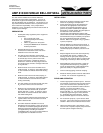
AMP 810/820 SINGLE BELLOW SEAL
The seal must be installed in accordance with these
instructions and plant safety requirements. If you are in
doubt about any phase of installing this mechanical seal,
stop the installation and get assistance. The decision to use
any American-Marsh mechanical seal in a particular service
is the customer’s responsibility. If the pumped fluid is
hazardous or toxic, appropriate precautions must be taken to
contain any seal leakage.
PREPARATION
1. Follow plant safety regulations prior to equipment
disassembly:
• lock out motor and valves
• wear designated personal safety
equipment
• relieve any pressure in the system
• consult plant MSDS files for hazardous
material precautions
2. Disassemble the pump in accordance with
manufacturer’s instructions so the seal can be
installed over the end of the shaft.
3. The shaft or sleeve diameter must be within
+0.000/-0.002 inch of nominal size. The shaft must
be smooth (32μ inch R
a
) and free from nicks,
grooves and corrosion. Replace the sleeve or
shaft if worn. Remove all sharp edges and burrs
from shaft keyways, threads, and edges where the
O-ring will slide.
4. Maximum shaft runout at seal chamber face is
0.002 inch FIM. To measure, mount dial indicator
on seal chamber and indicate shaft while rotating
shaft.
5. Maximum axial movement of shaft (end play) is
0.005 inch FIM. To measure, mount dial indicator
on shaft and indicate seal chamber face while
moving shaft axially.
6. The seal chamber face must be smooth (63μ inch
R
a
) and free of nicks, burrs and corrosion.
7. Maximum out-of-squareness of the seal chamber
face to the shaft is 0.002 inch FIM, (0.003 inch
FIM for shaft size > 3 inch). To measure, mount
dial indicator on shaft and indicate seal chamber
face while rotating shaft.
8. If the seal gland is piloted to the seal chamber, the
register surface must be concentric to the shaft
within 0.005 inch FIM.
9. The bellow elastomer installed in the seal is
identified on the seal drawing. There may also be
an alternate set of bellows packaged with the seal.
Determine what bellow elastomer is suitable for
your application by consulting an elastomer
compatibility table. Be sure the correct bellows for
your application are installed in the seal.
INSTALLATION
1. Remove the protective packaging from the seal.
Check for any damage, and wipe clean.
2. Fit the seat/mating ring into the gland plate as
described in the appropriate seat instruction
manual. Check that the gland plate o-ring or
gasket is in position and will not be displaced
during fitting, and then position the gland plate on
the shaft clear of the seal location.
3. Lubricate the shaft and bellows sparingly with
silicone lubricant or with other lubricant compatible
with the bellows and your machinery and product.
Do not use petroleum lubricants on EPDM
bellows. Make sure the gland O-ring or gasket is
in place (if required).
4. Slide the AMP 810 or 820 seal onto the shaft. If
the seal doesn’t slide over the shaft, do not force.
Ensure that the end of the shaft or sleeve is
chamfered properly and that the parts are free of
burrs.
5. Wipe the lapped surface of the seal face/primary
ring perfectly clean and dry. Install the seal
housing; locate the gland plate squarely on the
fixing studs, and pull on the plate to compress the
seal spring as necessary to fit the retaining nuts.
6. Reassemble the pump components. Orient the
seal gland with the flush port up (if supplied), if
access to piping permits. Install and tighten the
gland nuts evenly in a diagonal sequence.
7. Connect and align piping and motor coupling.
8. Rotate the shaft by hand to check for obstructions
or contact. Do not start the equipment dry.
PIPING AND OPERATION
1. Install an appropriate seal flush system. The flush
line should be connected to the seal gland. A flush
from a clean external source (API Plan 32) can
always be used, and should be used for abrasive
services. For clean cool products, use a
discharge bypass (API Plan 11) or a suction
bypass (API Plan 13). For clean hot products, use
a discharge bypass through a cooler (API Plan
21), preferably with a throat bushing. Vertical
pumps should be piped to vent air from the seal.
2. Do not start the pump dry. Open valves to flood
the pump. Vent air from the pump casing and seal
chamber. Make sure the seal flush lines are clear.
3. Observe the startup from a safe distance. If the
seal runs hot or squeals, stop the pump and check
the flush system and gland centering.
Component
Elastomer Bellow
Non-Pusher Design



